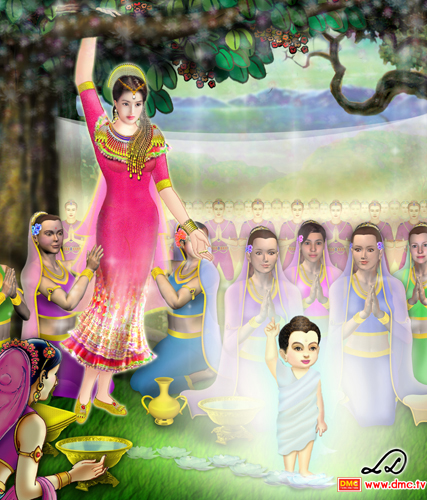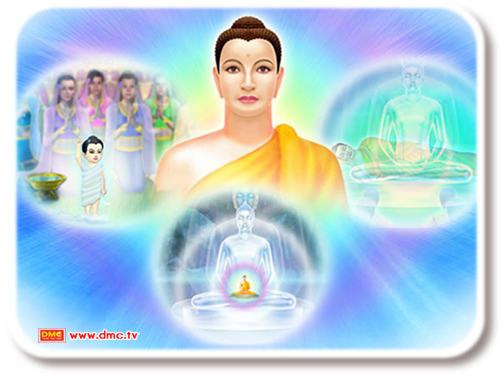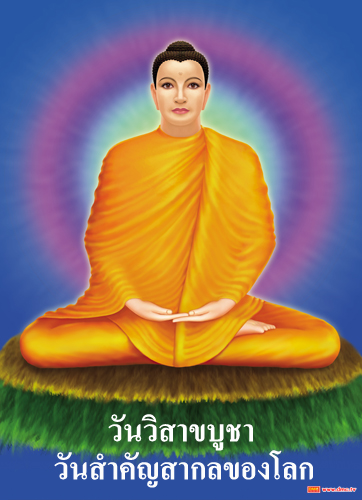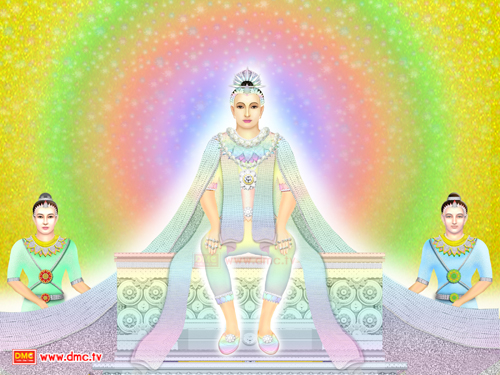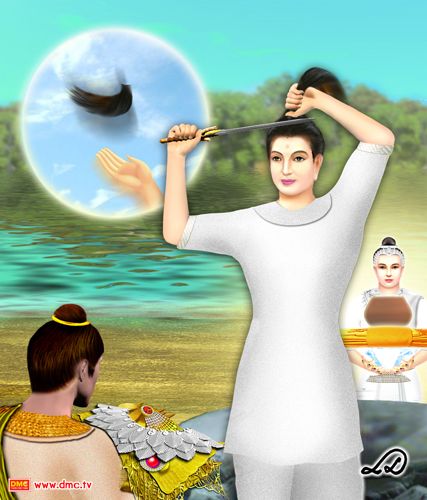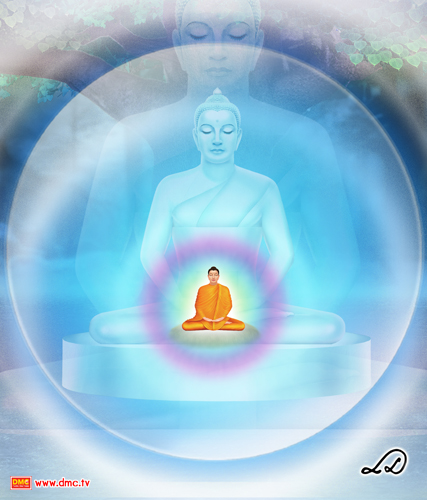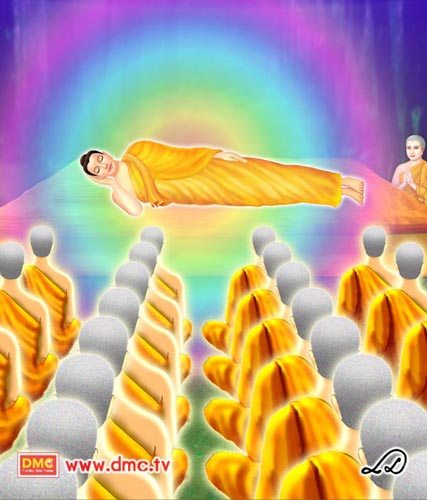
Vesak Day InternationalWhat is "Vesak"? It is the full moon day in the ancient Indian month of
Vesakha, the night Siddhartha Gautama became the
Buddha or "Awakened One." This year's celebration is referred to as Buddha Jayanti
("Buddha Festival") in India and elsewhere because it is the 2600th Vesak. The following is a short biography from a sermon by Thai master Ven. Dhammjayo. It recounts the Buddha's quest for supreme enlightenment, which means not only rediscovering the path to freedom (nirvana) but the ability to effectively teach that path.
The appearance of the Buddha is similar to the sun as it rises because it shines its light on all beings equally and without bias. Prince Siddhartha was born to benefit and bring happiness to human beings, devas
("shining ones"), otherworldly entities, happy and unhappy spirits, and animals. He wanted them all to be happy by finding the solution to the problem of suffering (dukkha, "woe, ill, unsatisfactoriness, distress, sorrow, lamentation, sadness, depression).
The Perfection of the PursuitTo describe the Buddha’s kindness briefly is like water passing through a pinhole while his actual kindness is like the ocean's water. This is because he began benefiting others since he was the Bodhisattva, the being bent on supreme enlightenment.
He was on a quest to find enlightenment by himself to teach the living beings the way. He did this intentionally. He pursued the "perfections" (paramis) for countless aeons (
kalpas) and great
-kalpas until his perfections were full.
He was reborn as King Setaketu in a space world named Tusita, a heavenly or celestial plane. He governed there waiting for the proper time to take rebirth on Earth to complete his quest.
When the proper time arrived, the devas
there encouraged him. Brahmas (mighty divinities) from other of universes came together to invite the Bodhisattva to be reborn in the human world.
Setaketu determined that the five factors -- world, country, human’s average lifespan, noble family and chaste mother -- had come together. So he passed from Tusita and chose to this world, a continent or island in Buddhist cosmology, in the spiritually developed country of India. The full lifespan of humans at that time was 100 (some say 120), and he chose the Shakya royal family and Queen Maya as his mother.
 Queen Maya as a Sala tree dryad or Salabhanjika (art.com)
Queen Maya as a Sala tree dryad or Salabhanjika (art.com)Before the Buddhist Era for 80 years at Lumbini Garden -- a garden park between the cities of Kapilavastu and Devadaha [possibly in Afghanistan, almost certainly not in Nepal, both of which were areas on the frontier of India], which as not a unified country but a collection of 16 territories that shared cultural and linguistic similarities.
He was born as Siddhartha on the full moon day of the sixth lunar month (Vesakha). In the oldest Buddhist tradition, this full moon day is thrice blessed because it was a birthday, enlightenment day, and final passing day.
When Queen Maya was pregnant, she could clearly see the Bodhisattva sitting in lotus posture because she kept the precepts well and meditated (cultivated herself) a lot. While she was delivering him, she stood holding the branch of a tree (as salabhanjikas do). The Bodhisattva’s feet went out first. When his feet touched the ground, he could stand and walk at once. It was a miracle!
Myth has grown around this day in an apparent attempt to make it clear who this great being was. Certainly, the world shook for his mother and her retinue, for the father as the heir of his kingdom was born to them after many years of marriage:
Myths and MiraclesWhen the Bodhisattva was born he stood stably and proclaimed the objective of his birth: He was the best and noblest of humans to be born in the world, and this was his last birth.
When the Bodhisattva was born, a remarkable brightness covered the world and thousands of universes ("world systems" in the unbounded multiverse view inherent in
Buddhist cosmology). So remarkable was this luminosity that it revealed the darkness of perhaps the most abysmal "hell" realm in Buddhism -- interstitial hell. World systems are globes, like bubbles pressing against each others:
There are desolate gaps between these universes where particularly bad individuals may be reborn [perhaps George W. Bush, George H. Bush, Dick Cheney, Idi Amin, Gen. Than Shwe, Adolf H., or
Mara Namuci]. It is dark, and they are alone. But this light illuminated that hyperspace between world systems, and the beings there saw there were others, or so the legend goes. Otherwise, the worst hell is
Avici, which is tormented by fire.
Thirty-two auspicious omens appeared. In thousands of universes that brightness extended. The blind saw, the deaf heard, the mute spoke, humpbacks straightened, the lame became well, imprisoned animals were freed, hell fire was extinguished, hungry ghost were sated, animals gained peace and fearlessness untroubled by symptoms and defilements, and so on. These are miracles that rarely appear in the cosmos.
When Prince Siddhartha grew up, he was taught by the best teachers in his father's country, getting the equivalent of a university education and special training in royal leadership, crafts, arts, war, and various professions. (This was to become evident by the breadth of his examples and similes when he became a Universal Teacher; his other possible destiny would have been to become a Wheel Turning Monarch).
In seven days he was able to grasp the knowledge his teachers had taken a lifetime to grasp. Although the prince was good looking, wealthy, influential, graceful, and had many other excellent qualities, he was kind, humble, and careful. This was in marked distinction to his cousin Devadatta.
The Great RenunciationAt 29, when he finally saw or, more likely,
recognized what he was seeing -- sorrow (old age, sickness, and death) and a means of finding an escape from these miserable inevitabilities (a wandering spiritual seeker), he knew immediately that it would be profitable to renounce the world and pursue compassion and wisdom.
He should don an ascetic robe and lead the noblest life he could, one aimed at finding the path of freedom (
vimutti-magga), the path of purification (
vissudhi-magga), the ultimate freedom from sorrow.
Prince Siddhartha, having been married off at 16 to his 16-year-old cousin Yasodhara, rode off at 29 on his white horse, Kanthaka, to renounce the world. He reached the river Neranjara on the border of his father's kingdom. [Wisdom Quarterly speculates that this was the
Kabul river (Kubhā or Kabol) or possibly the mysterious
Saraswati.] He threw off his royal markers (hair, clothes, beard, jewelry), donned a simple robe, and crossed over in search of truth -- the way to save himself and others from suffering.
 Mara's daughters dance to divert the Bodhisattva from his quest (What-Buddha-said.net)
Mara's daughters dance to divert the Bodhisattva from his quest (What-Buddha-said.net)
The Buddha’s Enlightenment Day After the Bodhisattva made an effort for six years, succeeding in his meditation (
samadhi) but finding it insufficient to be freed from
Samsara, the Cycle of Birth and Death, he sat to meditate under a tree.
On the full moon day of a month called
Vesak, he sat solidly in the lotus pose. The Bodhi tree provided shade and grounded him. Mara -- the tempter, corrupter, and embodiment of death -- used his supernatural power to throw thunderbolts at the Bodhisattva to scare him off. But Mara was unable to succeed because of the Bodhisattva’s strong intention.
Even if his blood and muscles should shrivel and waste away, leaving only leathery skin, prominent tendons, and a skeletal frame, he would not stand up from his meditation seat unless he reached enlightenment.
When Mara and his frightful armies understood the Bodhisattva’s intention, they were frightened. Their legions were taunted to move against the Bodhisattva in a fabulous display of demonic might and vainglory. The Bodhisattva was unmoved as their spears and arrows fell to the wayside as flowers. Mara adopted a new tactic. He claimed that the Bodhisattva was sitting on his seat, a rock slab under the Bodhi tree.
The Bodhisattva was unshaken and continued to still his mind. Mara demanded an answer, and the "demons" (
yakkhas) concurred. This was Mara's seat. "Who will act as witness for you that you have any right to sit there?" Mara demanded. The Bodhisattva placed one hand on the Earth in the
Earth-witnessing mudra (hand gesture), and the Earth responded by trembling. The armies fell back in fear.
 Earth-witnessing mudra, gilded statue, Sukhothai, Thailand
Earth-witnessing mudra, gilded statue, Sukhothai, ThailandMara adopted yet another tactic. He sent in his "daughters" -- Taṇhā, Arati, and Rāga, personifications of Craving, Aversion, and Passion -- to dance and seduce the Bodhisattva.
The Bodhisattva overcame them by the power of his well-accumulated "perfections" (
paramis):
- Dāna: generosity, unselfishness, beneficence
- Sīla: virtue, morality, proper conduct
- Nekkhamma: renunciation, letting go, detachment
- Paññā: transcendental wisdom, insight
- Viriya: energy, diligence, vigor, effort
- Khanti: patience, tolerance, forbearance, acceptance
- Sacca: truthfulness, honesty
- Adhiṭṭhāna: determination, resolve
- Mettā: loving-kindness, friendliness
- Upekkhā: impartiality, equanimity, serenity
The Bodhisattva determined Dharma precisely -- that is, he followed the 12 links of causation in a formula that has come to be known as Dependent Origination. He ran through it in his mind forward and back. His Dharma determination caused the Earth to quake 12 times. He finally understood the origin of suffering, glimpsed nirvana, and was enlightened. He realized various things through the three watches of the night and by dawn was the Buddha.
When the Buddha was awakened, having overcome illusion, the completely dark interstitial at once became bright. The ocean's saltwater became sweet. Rivers did not flow. The disabled were enabled. Fetters were undone. And throughout this world-system, the celestial beings cried out in honor of this amazing occurrence.
Determined to share his enlightenment, the Buddha summoned the greatest kindness known to being by teaching them to attain the same freedom. He taught the path to complete liberation for 45 years, traveling by foot in stages to disseminate and establish the
Dharma in many regions. It became the first missionary religion in history when early on he sent out 60 enlightened disciples.
He taught the True Wheel clearly like a lion's roar, his resonant and engaging voice using many similes all kinds of people were able to related to. For farmers in agrarian India, he taught in examples they could readily grasp. For brahmins and intellectuals in sophisticated spiritual circles, he used language and examples they could readily relate to.
He used discourses, aphorisms, parables, birth tales, exposition, verse, inspired utterances, and even silence -- in many ways teaching and healing the worst disease of all, false-views. He came to be known as the Master Physician because so many people attained the Eye of the Dharma -- that is, they saw the Truth, glimpsed nirvana, and uprooted their defilements -- as he taught.
In this way, he set right what had long been upside down. He uncovered what had for a long time been concealed. He explained things that for generations had been misunderstood or had remained obscure (parts of the Vedas, ancient lore, the teachings of ancient teachers, etc.) and esoteric.
He lit the way for wanderers and seekers like a lantern held up in the dark. In this way, a great number of beings (humans as well as
devas) found and comprehended the subtle and profound Dharma. (The teaching that leads to the Truth, which is the
real and unchanging Dharma people realize).
The Buddha’s Passing
When the Buddha was 80 years old, he traveled to Kusinara, India to pass into nirvana without remainder in the Sala grove outside the hamlet. It was the full moon day of Vesak, year 1 in the Buddhist Era.
- NOTE: To say that he "died" would be completely mistaken, for anyone who dies is reborn elsewhere. Fully-enlightened individuals (arhats) do not die and are not reborn. They have escaped the cycle of birth and death and made an end of ALL suffering, which is the ultimate goal of Buddhism.
Even though his physical body has dissolved, his Dharma body (Dhammakaya) has touched nirvana. Before he passed away, his last sermon stated that no physical body was stable. Decay is common to all "conditioned" (composed of parts) things. So one should avoid being careless.
This summarizes the story of the Buddha’s birth, enlightenment, and passing. It is the good story and inspires us to pursue the perfections by following him. He is the Greatest Master in the World! Ever! So, we should recall him every the full moon day of the sixth lunar day or Vesak Day.
Buddhist Communities light Vesak LanternsVesak is the day when the four Buddhist communities (monks, nuns, and male and female Buddhists) are reminded of the Buddha's liberating message. The perfection of his pursuit from his birth to passing is recollected. The message is that the gates of the death are open, which is rarely the case on Earth. The wise study, practice, and fulfill the Dharma, the guiding light that leads to an excellent human rebirth, an exalted heavenly rebirth, or if one wishes, the ultimate goal, the end of all suffering that is nirvana.
Buddhists come together to meditate and engage in other meritorious deeds that help one attain Dhammakaya, the body of enlightenment.
The symbolism of the Dhammakaya movement's Vesak celebration is simple: light a lantern, circumambulate (clockwise) a Buddhist pagoda in honor of the Teacher who led the way and our own inner potential for personal
buddhahood. The exterior is made bright by a parade of candle light as 1,000 people join together in Los Angeles. The inside is bright by even one person practicing the
Dharma light.
 (Sunciti Sundaram/Flickr.com)
(Sunciti Sundaram/Flickr.com)
















